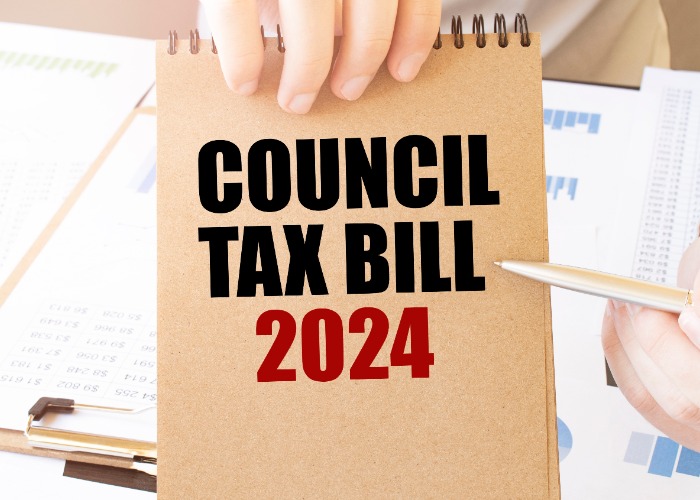Council Tax receipts in England up 61% in past decade

With Council Tax receipts soaring to £38.5 billion in 2023/24, we reveal the 10 Local Authorities recording the biggest increases. Does yours make the list?
Council Tax receipts in England have rocketed by 61% in the past 10 years and more than tripled since 2000, shocking new research has found.
According to analysis of Government figures by the Taxpayers’ Alliance, Local Authorities raked in £38.5 billion in 2023/24, up from £12.2 billion in 2000/01.
To put these figures into context, this is an increase of more than 214% since the Millennium.
During 2021/2022, receipts soared by 7.5%, which was the largest hike in nearly 20 years.
Opinion: 5 reasons the Council Tax system is broken
The areas with the biggest increases
Durham saw the largest rise during the first quarter of this financial year, with receipts increasing by 34% compared with the previous year.
Wiltshire and Liverpool took second and third places on the list, with increases of 19.9% and 17.8%.
Overall, town halls in the North East are reaping the most benefit, with average Council Tax receipts increasing by 11.7%.
In contrast, Local Authorities in the South East saw the smallest increase at 5.7%.
The table below shows the 10 Local Authorities with the highest percentage increase in receipts in the first quarter of 2024/25.
|
Local authority |
Class |
April to June 2023 (£ million) |
April to June 2024 (£ million) |
Percentage increase from Q1 2023-2024 |
|
Durham |
Unitary Authority |
73,306 |
98,412 |
34.2% |
|
Wiltshire |
Unitary Authority |
108,072 |
129,631 |
19.9% |
|
Liverpool |
Metropolitan District |
60,627 |
71,392 |
17.8% |
|
Hackney |
London Borough |
34,325 |
40,017 |
16.6% |
|
Wigan |
Metropolitan District |
48,433 |
55,419 |
14.4% |
|
Westminster |
London Borough |
44,646 |
51,072 |
14.4% |
|
Enfield |
London Borough |
53,070 |
60,457 |
13.9% |
|
Tower Hamlets |
London Borough |
42,218 |
47,874 |
13.4% |
|
Braintree |
Shire District |
32,596 |
36,697 |
12.6% |
|
Isles of Scilly |
Unitary Authority |
720 |
802 |
11.4% |
Source: The Taxpayers’ Alliance
In another shock statistic, the Taxpayers’ Alliance found that local governments handed senior executives £29.7 million in exit payments in 2023/24, up from £20.5 million in 2014/15.
Council Tax increases 2024/25: how some can cut their bill
A sign of things to come?
Worryingly, there are fears that our Council Tax burden could increase even further under the new Government.
Although nothing has been confirmed, there is speculation that the Government may hike the tax to plug a £22 billion hole in public finances.
It has been rumoured that the Government may be planning to scrap existing Council Tax bands, with households paying a percentage of their home’s value each year.
Unsurprisingly, this change would see both winners and losers.
In theory, those in regions with relatively low property prices could see their bills fall, while people in areas such as London and the South East would almost certainly experience a significant increase.
To reiterate, these remain rumours at this stage, and the party did appear to rule out any changes to banding in the run-up to the General Election.
In fact, we won’t know the party’s plans for Council Tax (and other taxes) until Chancellor Rachel Reeves delivers her Autumn Budget on 30 October.
What about bankrupt councils?
In most cases, Local Authorities can increase their Council Tax bills by up to 5% per year –anything more than this would require a referendum.
Frustratingly, however, a quirk of Council Tax regulation means that bankrupt Local Authorities can impose a higher increase.
This year, Local Authorities of Birmingham, Slough, Woking and Thurrock have had dispensation to increase rates by up to 10%, although some imposed slightly smaller hikes.
And despite surging Council Tax receipts, evidence suggests that more and more Local Authorities are struggling to balance the books.
According to a survey from the Local Government Information Unit, nearly one in 10 council fears they will go bankrupt within the next 12 months – which could mean higher bills for residents in those areas.
But, as we've written about previously, rising levels of Council Tax debt proves that current bills are already unsustainable, with Government data revealing that arrears reached £6 billion in March 2024.
Have your say
What do you think about this research? Does it make your blood boil to read that councils are taking more of our money while services are inadequate?
Or perhaps you think that Local Authorities have little choice but to increase bills with so many on the brink of bankruptcy?
Let us know your thoughts in the comments below.
Most Recent
Comments
-
If you had completed the same article for Wales the figures would have been massively higher. LA's in Wales have been allowed to increase the CT without limits for years as opposed to the maximum 4.99% permitted in England and double digit increases have been common, it was 12.5% this year. It is sickening that in Pembrokeshire self taught amateur property development councillors use CT funds to enter into money straight down the pan projects as if they are children is a sweet shop. Additionally of course the Welsh government use CT as their own wealth tax and encourage their LA's to pummel those people that actually pay the CT as most get relief from it.
REPORT This comment has been reported. -
Councils need to get their priorities right!!! They are not funded by taxpayers to provide jobs nor to support charities but to provide NECESSARY services. Presently just one executive member can make a costly bad decision that would have been avoided if full Council consultation meetings had made decisions. Pet causes that are given "grants" must be stopped, causes that are worthwhile will attract their own funding. "Free" programmes like funding free travel must cease,
REPORT This comment has been reported.
Do you want to comment on this article? You need to be signed in for this feature









19 August 2024